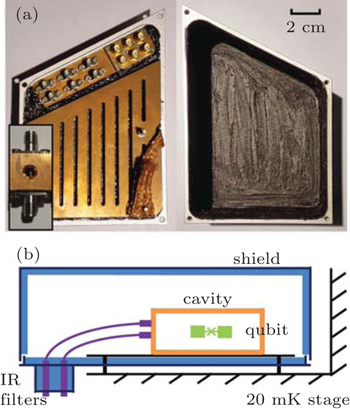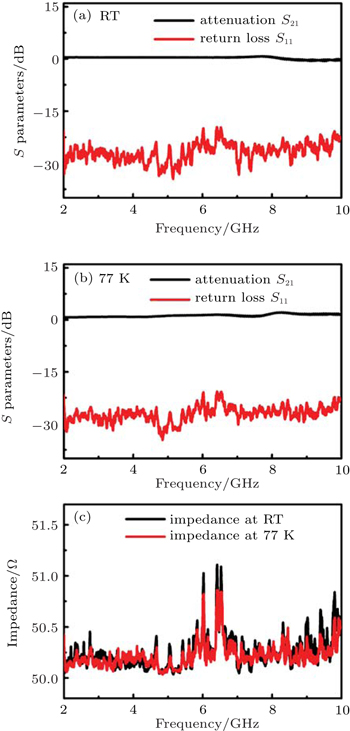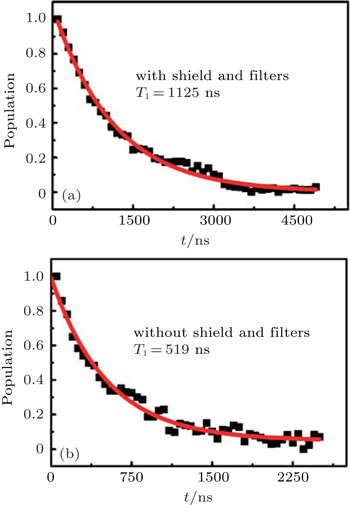† Corresponding author. E-mail:
‡ Corresponding author. E-mail:
Project supported by the National Natural Science Foundation of China (Grant Nos. 91321310, 11274156, 11474152, 11474153, 61521001, and 11504165) and the State Key Program for Basic Research of China (Grant Nos. 2011CB922104 and 2011CBA00205).
One of the primary origins of the energy relaxation in superconducting qubits is the quasiparticle loss. The quasiparticles can be excited remarkably by infrared radiation. In order to minimize the density of quasiparticle and increase the qubit relaxation time, we design and fabricate the infrared filter and shield for superconducting qubits. In comparison with previous filters and shields, a nonmagnetic dielectric is used as the infrared absorbing material, greatly suppressing the background magnetic fluctuations. The filters can be made to impedance-match with other microwave devices. Using the as-fabricated infrared filter and shield, we increased the relaxation time of a transmon qubit from 519 ns to 1125 ns.
As artificial atoms, superconducting qubits are considered as one of the most promising approaches to realize quantum computing.[1–4] In order to realize practical quantum computing, a long energy relaxation time (T1) is required. Recent studies found that the energy losses, including surface losses,[5] dielectric losses,[6] and quasiparticle losses,[7,8] will induce the energy relaxation in superconducting qubits. The surface losses and dielectric losses can be optimized by improving the qubit design and fabrication. Since superconducting qubits work at about 20 mK, which is far below the temperature corresponding to the superconducting energy gap Δ, the equilibrium quasiparticles in the superconducting circuits tend to vanish.[9] Therefore, the quasiparticle losses mainly come from the non-equilibrium quasiparticles excited from the infrared radiation (IR) of environment.[10] Moreover, the recombination of these non-equilibrium quasiparticles is slow.[11]
In experiments, qubits are usually covered by a metal sample box. However, IR can still enter the sample box through the control coaxial cables, connectors, and the lid joint then generates quasiparticles. The total number of quasiparticles can be calculated by the rate equation[11]



In order to suppress IR from 700 mK shield and coaxial cables, different kinds of shields and filters have been designed. The materials generally used are energy lossy powders[9,12] (copper, stainless steel, and carborundum) and Eccosorb[13,14] (CR-110, CR-124, FGM-40, and GDS from Emerson&Cuming), respectively. However, most of these materials are magnetically loaded and will cause magnetic fluctuations at low temperature. Since superconducting qubits are very sensitive to magnetic noise, it is better to find nonmagnitic material to improve the qubit performance.
In this paper, we present a kind of nonmagnetic infrared filter and shield for superconducting qubits. We use a nonmagnetic epoxy which can block infrared photons. The filter is coaxial with Stycast 2850FT as the dielectric. The shield is made of aluminum with Stycast 2850FT and carborundum powders coating on the wall. We use a three-dimensional (3D) transmon to test the effect of the filters and the shield. The energy relaxation time of the transmon increases remarkably.
In superconducting quantum computing, microwave coaxial cables are used to transmit microwave fields to control and measure the qubits. The insert loss of these microwave cables increases with frequency in the microwave region then gradually decrease in the infrared region. External noise can go down along the cables to the qubits. Therefore these cables have to be carefully filtered to protect qubits from noise. In general, commercial microwave filters are used to absorb external noise while allowing a signal to pass through. Unfortunately, most of these microwave filters cannot filter infrared light since IR frequency is much higher than microwave frequency.[15] Therefore, we need to fabricate suitable infrared filters.
There are two important issues for designing an infrared filter. One is the geometric size to satisfy the requirement of the impedance matching with microwave devices. The other is selecting the correct filling materials to attenuate IR. In our design, we choose a black color epoxy, Stycast 2850FT from Emerson&Cuming, which is a kind of nonmagnetic material. In order to realize the 50 Ω impedance, we perform the impedance calculation firstly. For simplicity, a coaxial geometry is chosen. For a coaxial cable of inner radius a and outer radius b with dielectric in between, the impedance is[16]

Because the filter is relatively small, we can integrate 12 filters together in each copper block. Among them, 6 filters are impedance matched, as described before. The other 6 filters are used for direct-current (DC) lines. Therefore, they are designed to mismatch 50 Ω impedance purposely. We use SMA-KYD47 connectors whose radius of pins is 1.27 mm.
The infrared shield is designed to prevent the sample from IR coming from the still shield (700 mK) of the dilution refrigerator. We made the shield with an aluminum box surrounding the qubit sample box. The shield box is composed of two pieces, a plate and a cover. Since at low temperature aluminum is a thermal insulator, two oxygen free copper blocks are designed for thermal anchor. One is mounted inside the shield box, and the other is mounted outside the aluminum plate. They are connected by a copper tape. The copper block outside the shield is thermally anchored to the mixing chamber of the dilution refrigerator (Fig.
We mount the infrared filters inside the shield and then use the Stycast 2850FT to seal the seam. In addition, to further prevent IR from reaching the sample box, we spread a kind of home made IR photon absorbing material on the inside wall of the shield. The material is combined with Stycast 2850FT and carborundum in a ratio of 60% to 40% by volume. The carborundum powders have 6 different sizes with 60, 300, 400, 800, 1300, and 3000 mesh, respectively. The ratio of them is almost the same by volume. We mix all the carborundum powders with Stycast 2850FT, and spread the mixture inside the shield. After curing, the mixture is very rough and hard. Even if some infrared photons leak into the shield, they will be quickly absorbed by the material.
We measure the attenuation (S21) and return loss (S11) of the filter at room temperature (RT) and 77 K by a network analyzer from 2 GHz to 10 GHz. The attenuation and the return loss are defined as S21 = 10lg (P2trans)/(P1in) and S11 = 10lg (P1ref)/(P1in), where P1in is the microwave power incident on the input of the filter, P1ref is the microwave power that is reflected off to the input of the filter, and P2trans is the transmitted microwave power to output of the filter. For testing at 77 K, the filter is immersed in liquid nitrogen. Figures
From the return loss, we can calculate the impedances of the filter at different frequencies by[16]

In order to test the effect of our filter and shield, we measure the energy relaxation time of a 3D transmon. The cavity is made of copper with the resonance frequency of the TE101 mode 8.6814 GHz. The transmon is fabricated on an oxide silicon substrate. It is composed of a single Josephson junction and two pads (250 μm × 500 μm), which are patterned using standard e-beam lithography, followed by double-angle shadow evaporation of aluminium. The thicknesses of the aluminium film are 30 nm and 80 nm, respectively. Then the lift-off is conducted to form the final structure. The chip is diced into 3.00 mm × 6.80 mm size to fit into the 3D rectangular cavity.
In order to do a comparison test and check whether the shield and filters can improve the qubit’s energy relaxation time, the same sample is cooled down to 20 mK in a dilution refrigerator twice. The first time, the sample is mounted in the shield with filters, and the second time, the shield and filters are removed.
The measurement system is ordinary microwave heterodyne,[17] and the readout is performed with the so-called “high power readout” scheme.[18] By sending in a strong power microwave on-resonance with the cavity, we acquire the transmitted amplitude of the microwave, which reflects the state of the transmon due to the non-linearity of the cavity quantum electrodynamics (c-QED) system.[19,20]
In both experiments, we first measure the saturation spectroscopy. We use a low power continuous microwave with different frequencies to irradiate the transmon, and we find that the transition frequency of the ground state to the first excited state is ω01 = 2π × 5.9601 GHz. Then, at the transition frequency, we excite the transmon from the ground state to the first excited state. After a period of time, the population in the first excited state is measured. By varying the waiting time t, we obtain the qubit population in the excited state as a function of t (see Fig.
The different energy relaxation times for the same sample measured with and without the shield and filters indicate that our shield and filters work well at 20 mK and greatly reduce the quasiparticle losses. However, the energy relaxation time is still relatively short compared with previous works.[5] The main reason may be that the transmon is fabricated on oxide silicon substrate, and the energy relaxation due to the surface loss is now the dominant source.[5]
We have designed a new nonmagnetic infrared radiation filter with excellent performance in the relevant frequency region. It can filter the IR photons from control coaxial cables. The shield coated with nonmagnetic IR absorbing material not only blocks the IR from the environment, but also absorbs the IR photons which leak into the shield. By measuring the energy relaxation time of a 3D transmon with and without the filters and the shield, we find the energy relaxation time is almost 2 times improved. Therefore, this filter and shield are useful in the quantum information precessing with superconducting qubits.
| 1 | |
| 2 | |
| 3 | |
| 4 | |
| 5 | |
| 6 | |
| 7 | |
| 8 | |
| 9 | |
| 10 | |
| 11 | |
| 12 | |
| 13 | |
| 14 | |
| 15 | |
| 16 | |
| 17 | |
| 18 | |
| 19 | |
| 20 |





